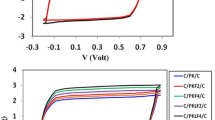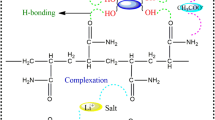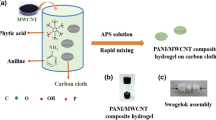Abstract
Electrochemical capacitors (ECs) are electrochemical devices that have reversible charge and discharge storage abilities. ECs consist of two electrodes and electrolyte sandwiched between the two electrodes. The electrolyte can be in the form of liquid, gel, or solid, whereby the liquid and solid polymer electrolytes have many disadvantages. Therefore, hydrogel electrolytes are ideal materials for flexible ECs. This study reports the poly (acrylamide) hydrogel, synthesized through free radical mechanism by mixing acrylamide, ammonium persulfate (APS), and clay. Acrylamide, APS, and clay were used as the monomer, initiator, and crosslinker, respectively. Then, sodium sulfate was added as a source of ions to prepare hydrogel electrolytes. Four different samples (SAM 1, SAM 2, SAM 3, and SAM 4) with different compositions of monomer and salt were developed. The structural and morphological studies were conducted using X-ray diffraction and field emission scanning electron microscopy. Electrochemical impedance spectroscopy was examined, and the study showed that SAM 4 with 40 wt% of sodium sulfate has the highest ionic conductivity (1.48 × 10–2 S cm−1) and the lowest activation energy (0.0582 eV) at room temperature. The electrochemical performance of fabricated supercapacitors has been examined by cyclic voltammetry (CV) and galvanic charge–discharge (GCD) measurements. The results of CV and GCD reveal that AC/SAM 4/AC has a better performance with a maximum specific capacitance of 133.6 F/g and 165.7 F/g at 5 mV/s and 300 mA/g, respectively. The prepared poly (acrylamide) hydrogel electrolyte has promising features for intelligent electronic devices.










Similar content being viewed by others
References
Liu C, Li F, Ma LP, Cheng HM (2010) Advanced materials for energy storage. Adv Mater 22(8):E28–E62
Bolufawi O (2018) Renewable energy integration with energy storage systems and safety. In: special topics in renewable energy systems, p 39
Gharehpetian GB, Agah SMM (2017) Distributed generation systems: design, operation and grid integration. Butterworth-Heinemann, Oxford
Mensah-Darkwa K, Zequine C, Kahol PK, Gupta RK (2019) Supercapacitor energy storage device using biowastes: a sustainable approach to green energy. Sustainability 11(2):414
Hou R, Gund GS, Qi K, Nakhanivej P, Liu H, Li F, Xia BY, Park HS (2019) Hybridization design of materials and devices for flexible electrochemical energy storage. Energy Storage Mater 19:212–241
Pal B, Yang S, Ramesh S, Thangadurai V, Jose R (2019) Electrolyte selection for supercapacitive devices: a critical review. Nanoscale Adv 1(10):3807–3835
Dhibar S (2017) Electrochemical behaviour of graphene and carbon nanotubes based hybrid polymer composites. In: Hybrid polymer composite materials. Elsevier, pp 211–248
Yang H, Liu Y, Kong L, Kang L, Ran F (2019) Biopolymer-based carboxylated chitosan hydrogel film crosslinked by HCl as gel polymer electrolyte for all-solid-sate supercapacitors. J Power Sources 426:47–54
Zhu Q, Zhao D, Cheng M, Zhou J, Owusu KA, Mai L, Yu Y (2019) A new view of supercapacitors: integrated supercapacitors. Adv Energy Mater 9(36):1901081
Sharma K, Arora A, Tripathi SK (2019) Review of supercapacitors: materials and devices. J Energy Storage 21:801–825
Gudavalli GS, Dhakal TP (2018) Simple parallel-plate capacitors to high-energy density future supercapacitors: a materials review. In: Emerging materials for energy conversion and storage. Elsevier, pp 247–301
Bashir S, Hina M, Iqbal J, Rajpar A, Mujtaba M, Alghamdi N, Wageh S, Ramesh K, Ramesh S (2020) Fundamental concepts of hydrogels: synthesis, properties, and their applications. Polymers 12(11):2702
Khan Y, Bashir S, Hina M, Ramesh S, Ramesh K, Lahiri I (2020) Effect of salt concentration on poly (acrylic acid) hydrogel electrolytes and their applications in supercapacitor. J Electrochem Soc 167(10):100524
Abbas Q, Gollas B, Presser V (2019) Reduced Faradaic contributions and fast charging of nanoporous carbon electrodes in a concentrated sodium nitrate aqueous electrolyte for supercapacitors. Energy Technol 7(9):1900430
Liu Y, Réty B, Ghimbeu CM, Soucaze-Guillous B, Taberna P-L, Simon P (2019) Understanding ageing mechanisms of porous carbons in non-aqueous electrolytes for supercapacitors applications. J Power Sources 434:226734
Li T, Hu J, Wei B (2019) Understanding of Anion transport in polymer electrolytes for supercapacitors. Adv Theory Simul 2(2):1800140
Ding W, Wei C, Wang S, Zou L, Gong Y, Liu Y, Zang L (2019) Preparation and properties of a high-performance EOEOEA-based gel-polymer-electrolyte lithium battery. Polymers 11(8):1296
Soni R, Bhange SN, Athira E, Chetry R, Kurungot S (2019) Synthesis of ultrathin PEDOT on carbon nanotubes and shear thinning Xanthan Gum-H2SO4 gel electrolyte for supercapacitors. ChemElectroChem 6(6):1861–1869
Peng H, Lv Y, Wei G, Zhou J, Gao X, Sun K, Ma G, Lei Z (2019) A flexible and self-healing hydrogel electrolyte for smart supercapacitor. J Power Sources 431:210–219
Liu Z, Liang G, Zhan Y, Li H, Wang Z, Ma L, Wang Y, Niu X, Zhi C (2019) A soft yet device-level dynamically super-tough supercapacitor enabled by an energy-dissipative dual-crosslinked hydrogel electrolyte. Nano Energy 58:732–742
Yang H, Ji X, Tan Y, Liu Y, Ran F (2019) Modified supramolecular carboxylated chitosan as hydrogel electrolyte for quasi-solid-state supercapacitors. J Power Sources 441:227174
Han Y, Dai L (2019) Conducting polymers for flexible supercapacitors. Macromol Chem Phys 220(3):1800355
Li H, Lv T, Sun H, Qian G, Li N, Yao Y, Chen T (2019) Ultrastretchable and superior healable supercapacitors based on a double cross-linked hydrogel electrolyte. Nat Commun 10(1):1–8
Paulsen H (2018) Synthesis and characterization of hydrogels prepared by free radical polymerization
Bashir S, Omar FS, Hina M, Numan A, Iqbal J, Ramesh S, Ramesh K (2020) Synthesis and characterization of hybrid poly (N, N-dimethylacrylamide) composite hydrogel electrolytes and their performance in supercapacitor. Electrochim Acta 332:135438
Khan Y, Bashir S, Hina M, Ramesh S, Ramesh K, Mujtaba M, Lahiri I (2020) Effect of charge density on the mechanical and electrochemical properties of poly (acrylic acid) hydrogel electrolytes based flexible supercapacitors. Mater Today Commun 25:101558
Mei J, Tan H, Li H, Ma B, Liu X, Jiang W, Zhang T, Li X (2018) Effect of sodium sulfate and nano-SiO2 on hydration and microstructure of cementitious materials containing high volume fly ash under steam curing. Constr Build Mater 163:812–825
Bashir S, Hina M, Ramesh S, Ramesh K (2021) Flexible and self-healable poly (N, N-dimethylacrylamide) hydrogels for supercapacitor prototype. Colloids Surf A: Physicochem Eng Asp 617:126377
Takei T, Ikeda K, Ijima H, Kawakami K (2011) Fabrication of poly (vinyl alcohol) hydrogel beads crosslinked using sodium sulfate for microorganism immobilization. Process Biochem 46(2):566–571
Li G, Zhang X, Sang M, Wang X, Zuo D, Xu J, Zhang H (2020) A supramolecular hydrogel electrolyte for high-performance supercapacitors. J Energy Storage 33:101931
Han L, Huang H, Li J, Zhang X, Yang Z, Xu M, Pan L (2020) A novel redox bromide-ion additive hydrogel electrolyte for flexible Zn-ion hybrid supercapacitors with boosted energy density and controllable zinc deposition. J Mater Chem A 8(30):15042–15050
Munshi MZA (1995) Handbook of solid state batteries and capacitors. World Scientific, Singapore
Kumar JS, Subrahmanyam A, Reddy MJ, Rao US (2006) Preparation and study of properties of polymer electrolyte system (PEO+ NaClO3). Mater Lett 60(28):3346–3349
Reddy MJ, Sreekanth T, Rao US (1999) Study of the plasticizer effect on a (PEO+ NaYF4) polymer electrolyte and its use in an electrochemical cell. Solid State Ion 126(1–2):55–63
Sreekanth T, Reddy MJ, Ramalingaiah S, Rao US (1999) Ion-conducting polymer electrolyte based on poly (ethylene oxide) complexed with NaNO3 salt-application as an electrochemical cell. J Power Sources 79(1):105–110
Chong MY, Numan A, Liew CW, Ramesh K, Ramesh S (2017) Comparison of the performance of copper oxide and yttrium oxide nanoparticle based hydroxylethyl cellulose electrolytes for supercapacitors. J Appl Polym Sci 134(13)
Ming NH, Ramesh S, Ramesh K (2016) The potential of incorporation of binary salts and ionic liquid in P (VP-co-VAc) gel polymer electrolyte in electrochemical and photovoltaic performances. Sci Rep 6(1):1–13
Chong MY, Liew C-W, Numan A, Yugal K, Ramesh K, Ng H, Chong T, Ramesh S (2016) Effects of ionic liquid on the hydroxylpropylmethyl cellulose (HPMC) solid polymer electrolyte. Ionics 22(12):2421–2430
Chong MY, Numan A, Liew C-W, Ng H, Ramesh K, Ramesh S (2018) Enhancing the performance of green solid-state electric double-layer capacitor incorporated with fumed silica nanoparticles. J Phys Chem Solids 117:194–203
Acknowledgements
This work was supported by Partnership Grant (RK001-2021) from Universiti Malaya and Japan—Nippon Sheet Glass Foundation for Materials Sciences and Engineering Grant (IF001-2019).
Author information
Authors and Affiliations
Corresponding authors
Ethics declarations
Conflict of interest
The authors declare that they have no conflict of interest.
Additional information
Publisher's Note
Springer Nature remains neutral with regard to jurisdictional claims in published maps and institutional affiliations.
Rights and permissions
About this article
Cite this article
Rafidi, N., Bashir, S., Hina, M. et al. Renewable and soft dynamic supercapacitors based on poly (acrylamide) hydrogel electrolytes and porous carbon electrodes. Polym. Bull. 80, 1285–1302 (2023). https://doi.org/10.1007/s00289-021-04032-x
Received:
Revised:
Accepted:
Published:
Issue Date:
DOI: https://doi.org/10.1007/s00289-021-04032-x




